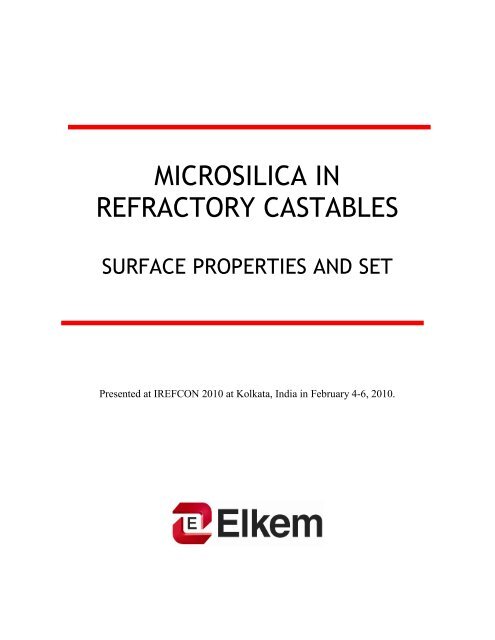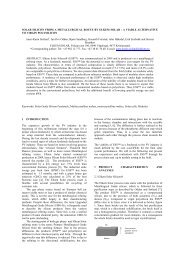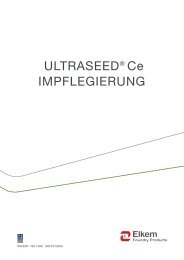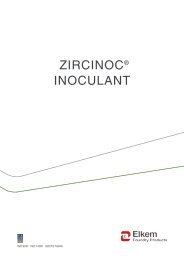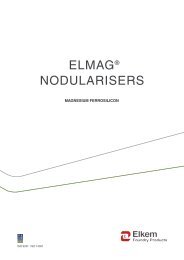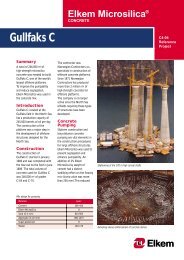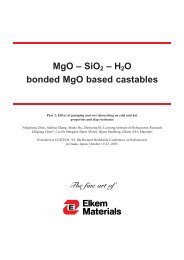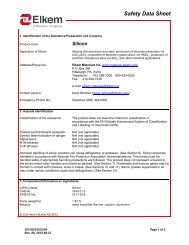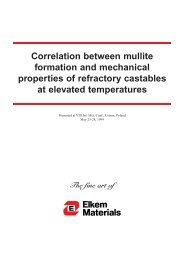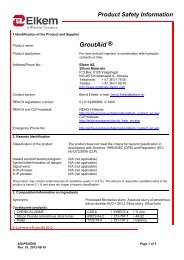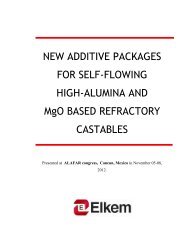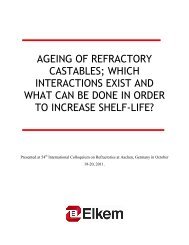Microsilica in Refractory Castables- Surface Properties and ... - Elkem
Microsilica in Refractory Castables- Surface Properties and ... - Elkem
Microsilica in Refractory Castables- Surface Properties and ... - Elkem
Create successful ePaper yourself
Turn your PDF publications into a flip-book with our unique Google optimized e-Paper software.
MICROSILICA IN<br />
REFRACTORY CASTABLES<br />
SURFACE PROPERTIES AND SET<br />
Presented at IREFCON 2010 at Kolkata, India <strong>in</strong> February 4-6, 2010.
MICROSILICA IN REFRACTORY CASTABLES<br />
-SURFACE PROPERTIES AND SET<br />
Bjørn Myhre,<br />
<strong>Elkem</strong> Silicon Materials, P.O Box 8126 Vaagsbygd,<br />
4675 Kristians<strong>and</strong>, Norway.<br />
bjorn.myhre@elkem.no<br />
Abstract:<br />
The surface of microsilica is covered by numerous<br />
silanol groups that are able to dissociate <strong>in</strong> an<br />
aqueous medium. This dissociation is responsible<br />
for a number of effects <strong>and</strong> <strong>in</strong>teractions that is seen<br />
when a castable is made that conta<strong>in</strong> both<br />
microsilica <strong>and</strong> cement. In this paper some of the<br />
effects of both deflocculants <strong>and</strong> gell<strong>in</strong>g<br />
mechanisms are expla<strong>in</strong>ed, with relevance to the<br />
use <strong>in</strong> low cement castables. Sett<strong>in</strong>g of such<br />
castables is also reviewed <strong>and</strong> the effect of<br />
microsilica on sett<strong>in</strong>g <strong>and</strong> the consequence of a too<br />
early demould<strong>in</strong>g is expla<strong>in</strong>ed<br />
<strong>Surface</strong> of <strong>Microsilica</strong><br />
Although the overall composition of microsilica is<br />
SiO 2 , the surface of a microsilica particle is not<br />
pla<strong>in</strong> siloxane bonds, but is also partially<br />
hydroxylated <strong>and</strong> hydrated. Producers of fumed<br />
silica (particularly Evonik Degussa) have been very<br />
active <strong>in</strong> the characterisation <strong>and</strong> modification of<br />
the silica surface <strong>in</strong> order to tailor specific<br />
properties of precipitated <strong>and</strong> fumed silica.<br />
In general, several connectivities of surface silicon<br />
have been identified by means of FT-IR- <strong>and</strong> NMRspectroscopy,<br />
as shown <strong>in</strong> Figure 1.<br />
Figure 1. <strong>Surface</strong> Si connectivities idientified on silica.
Based on theoretical <strong>and</strong> experimental results 1 , it<br />
seems that the maximum density of silanol (Si-OH)<br />
groups on the surface of silica is approximately<br />
4.6nm -2 .<br />
The surface of microsilica is covered by these<br />
silanol groups, although the presence of impurities<br />
plays some role, measurements have <strong>in</strong>dicated<br />
silanol densities rang<strong>in</strong>g from approximately 2 to<br />
4.5nm -2 for microsilica from silicon production.<br />
The good correlation between theoretical values<br />
<strong>and</strong> those found for microsilica may <strong>in</strong>dicate that<br />
the impurities of the microsilica are not smothered<br />
out on the surface of the microsilica particles but<br />
rather as discrete particles or dissolved <strong>in</strong> the silica.<br />
A comb<strong>in</strong>ation is probable.<br />
The presence of the silanol groups makes the<br />
microsilica easy to disperse <strong>in</strong> aqueous systems.<br />
Depend<strong>in</strong>g on the pH, a fraction of the silanol<br />
groups dissociate result<strong>in</strong>g <strong>in</strong>to a negatively<br />
charged surface. The surface charge or zetapotential<br />
can be measured <strong>and</strong> values higher than<br />
approximately 25mV (positive or negative) are<br />
often taken as an <strong>in</strong>dication of stable suspensions.<br />
Figure 2 shows a measurement of such a zeta<br />
potential for microsilica 971, <strong>and</strong> we see that the<br />
microsilica has a negative charge over the whole<br />
range. Due to dissociation of the silanol groups, the<br />
negative surface charge <strong>in</strong>creases with pH up to<br />
approximately pH 7. At higher pH than 7, the zeta<br />
potential flattens out <strong>and</strong> at still higher pH the<br />
microsilica starts to dissolve.<br />
Zeta-potential (mV)<br />
0<br />
-5<br />
-10<br />
-15<br />
-20<br />
-25<br />
-30<br />
-35<br />
1 2 3 4 5 6 7 8 9<br />
Figure 2 Zeta potential of microsilica 971 as a<br />
function of pH. A 10% microsilica slurry titrated<br />
with HCl <strong>and</strong> with zeta potential be<strong>in</strong>g measured<br />
us<strong>in</strong>g electro-acoustic techniques (Acoustosizer,<br />
Collodial Dynamics)<br />
pH<br />
<strong>Microsilica</strong> <strong>and</strong> deflocculants<br />
A refractory castable can be visualised as an<br />
aggregate structure with voids filled by aqueous<br />
slurry of microsilica, cement <strong>and</strong> other f<strong>in</strong>es. The<br />
negative charge of the microsilica makes it<br />
vulnerable for “attack” by cations which causes<br />
gell<strong>in</strong>g or solidification of the system. The<br />
concentrations necessary for gell<strong>in</strong>g are depend<strong>in</strong>g<br />
on type of cation but a quick calculation of the<br />
number of sites (silanol groups) per gram<br />
microsilica estimates that approximately<br />
0.15mmol/g microsilica could be sufficient for a<br />
full coverage. This quantity is for some less pure<br />
microsilicas available as water soluble impurities <strong>in</strong><br />
the microsilica itself, <strong>and</strong> an autogenous gell<strong>in</strong>g of<br />
such a slurry (e.g. 50%) may occur. Although any<br />
cation can be used for gell<strong>in</strong>g microsilica slurry, the<br />
characteristics of the resultant slurry are dependent<br />
on the charge <strong>and</strong> size of the cation that attaches. In<br />
the case of monovalent cations, the gell<strong>in</strong>g action<br />
has been attributed to a mechanism where it’s the<br />
hydrated cations that l<strong>in</strong>k adjacent silica particles.<br />
Such a gel normally feels quite “soft” <strong>and</strong> easy to<br />
liquify by agitation, while that from polyvalent<br />
cations tend to have a more “brittle” <strong>and</strong> “harder”<br />
appearance. With polyvalent cations, it is easy to<br />
imag<strong>in</strong>e that the excess positive charge of the cation<br />
l<strong>in</strong>ks with another negative charge on an adjacent<br />
microsilica particle. In this way three-dimensional<br />
networks may form <strong>and</strong> this is what we normally<br />
regard as gelled microsilica.<br />
In castables, enough cations are generally available<br />
from the cement <strong>and</strong> aggregates, <strong>and</strong> it is likely that<br />
the <strong>in</strong>itial sett<strong>in</strong>g of most castables is closely related<br />
to gell<strong>in</strong>g of the microsilica slurry. In the case of<br />
ultralow <strong>and</strong> no-cement systems with microsilica, it<br />
is probable that most of the sett<strong>in</strong>g is dependent of<br />
this solidification although it is often triggered by<br />
small amounts of additives that promote the gell<strong>in</strong>g.<br />
Such additives can e.g. be small quantities of<br />
cement.<br />
The absorption of polyvalent cations on the silanol<br />
sites is most likely a dynamic process <strong>and</strong> requires<br />
a certa<strong>in</strong> concentration <strong>in</strong> the water phase before<br />
absorption gets significant. The amounts of soluble<br />
cations necessary for gelation are therefore<br />
probably higher than just to attach to the silanol<br />
sites, but it seems reasonable to expect that the<br />
order of magnitude may be similar.<br />
The tendency to react with cations to produce a<br />
more or less rigid gel, creates problems if used <strong>in</strong>
densely packed castable systems where cement is<br />
present. The calcium <strong>and</strong> alum<strong>in</strong>ate cations from<br />
the cement dissolve <strong>and</strong> attack the otherwise fluid<br />
bond phase. To prevent this coagulation, the<br />
calcium ions have to be prevented from absorb<strong>in</strong>g<br />
on the microsilica. This may either be done by<br />
hav<strong>in</strong>g a pH below 5, but as this may affect sett<strong>in</strong>g;<br />
addition of a proper amount of a polyelectrolyte or<br />
a surface active agent is a common stratagem. The<br />
surface active agent, normally termed deflocculant<br />
(<strong>in</strong> Portl<strong>and</strong> cement based systems termed<br />
plasticiser or superplasticiser), is believed to absorb<br />
to the surfaces thus prevent<strong>in</strong>g the absorption of<br />
calcium but it also creates an equal, normally<br />
negative charge of the particles of the bond system.<br />
As the particles then will repel each other, cast<strong>in</strong>g<br />
can take place at reduced water additions.<br />
Deflocculants commonly used are polyphosphates,<br />
e.g. sodium hexametaphosphate (Calgon) at<br />
approximately 0.2 wt% addition level, <strong>and</strong><br />
polyacrylates (Darvan 811D, 0.05 wt %).<br />
The deflocculat<strong>in</strong>g mechanisms <strong>in</strong>volved falls<br />
normally <strong>in</strong>to two ma<strong>in</strong> groups or comb<strong>in</strong>ation<br />
thereof:<br />
1) Steric stabilisation, the deflocculant attaches to<br />
the f<strong>in</strong>es <strong>and</strong> the size of it prevents<br />
agglomeration of particles<br />
2) Electrostatic stabilisation, the deflocculant<br />
creates an equal electrical charge on the surface<br />
of the f<strong>in</strong>es. Electrostatic repulsion prevents<br />
particles from agglomeration.<br />
3) Comb<strong>in</strong>ation of 1) <strong>and</strong> 2):<br />
The recent years a new group of deflocculants have<br />
emerged on the market conta<strong>in</strong><strong>in</strong>g both steric<br />
groups <strong>and</strong> electrical charges which gives a<br />
“double” deflocculat<strong>in</strong>g effect (typically Castament<br />
FS20 from BASF). Below, <strong>in</strong> Figure 3, the structure<br />
of such a deflocculant is sketched. And <strong>in</strong> Figure 4<br />
the deflocculat<strong>in</strong>g action is visualised.<br />
Figure 3. Structure of a comb<strong>in</strong>ed steric <strong>and</strong> electrostatic deflocculant. A typically polycarboxylate “backbone”<br />
with polyether sidecha<strong>in</strong>s.<br />
Figure 4.Visualisation of the deflocculat<strong>in</strong>g mechanism of a compound like the one presented <strong>in</strong> Figure 3.
The use of deflocculants enables us to ma<strong>in</strong>ta<strong>in</strong><br />
flow of refractory castables for some time,<br />
sufficient to place the castable before sett<strong>in</strong>g<br />
(gell<strong>in</strong>g) commences. Sometimes sett<strong>in</strong>g may get<br />
adversely affected though, giv<strong>in</strong>g unacceptably<br />
long or short set times. This has been expla<strong>in</strong>ed<br />
with several mechanisms. For long set time with<br />
polycarboxylate ethers, one explanation is that the<br />
surface of the cement get “shielded” by the side<br />
cha<strong>in</strong>s <strong>and</strong> that longer side cha<strong>in</strong>s consequently<br />
retard more than shorter 2 .<br />
If deflocculants are added to microsilica slurry its<br />
effect can be followed by measur<strong>in</strong>g the result<strong>in</strong>g<br />
Zeta-potential of the microsilica.<br />
Castament FS 20 at 0.05% addition levels<br />
(approximately 0.3 mg/m 2 ref Fig. 6 <strong>and</strong> 7)<br />
Table 1 St<strong>and</strong>ard LCC castable composition.<br />
[wt%]<br />
<strong>Microsilica</strong> (18 or 24 m 2 /g) 8<br />
CA-14 [wt%] 6<br />
White Fused Alum<strong>in</strong>a. 3-5mm 10<br />
White Fused Alum<strong>in</strong>a. 0,5-3 mm 32<br />
White Fused Alum<strong>in</strong>a. 0-0,5mm 16<br />
White Fused Alum<strong>in</strong>a. -74 micron 12<br />
Calc<strong>in</strong>ed alum<strong>in</strong>a: CT 9FG 16<br />
Deflocculant: Castament FS20 0,01-0,1*<br />
Water [wt%] 4.15<br />
* St<strong>and</strong>ard dosage, 0.05%<br />
Zeta-potential (mV)<br />
0<br />
-10<br />
-20<br />
-30<br />
-40<br />
-50<br />
-60<br />
-70<br />
-80<br />
-90<br />
0.0 0.1 0.2 0.3 0.4 0.5 0.6 0.7 0.8 0.9 1.0 1.1 1.2 1.3 1.4 1.5 1.6 1.7<br />
Surfactant content (mg/m2)<br />
FS20<br />
Darvan 811D<br />
Calgon<br />
Figure 6. Zeta potential of microsilica 971 as a<br />
function of deflocculant addition represented as<br />
addition per surface area.<br />
In Figure 6 the effect of deflocculant additions to a<br />
10% microsilica (971) on zeta-potential is shown<br />
for three different deflocculants. Calgon is a<br />
sodium polyphosphate, Darvan is a sodium<br />
polyacrylate <strong>and</strong> FS20 is polycarboxylate ether as<br />
described above. For both Darvan 811D <strong>and</strong><br />
Calgon, additions to the microsilica slurry result <strong>in</strong><br />
an <strong>in</strong>creased negative surface charge, zeta potential.<br />
This <strong>in</strong>creased zeta-potential strengthens repulsion<br />
between particles <strong>and</strong> stabilise the slurry. For the<br />
comb<strong>in</strong>ed deflocculant FS20, the electrostatic effect<br />
is less pronounced but this was expected as the<br />
steric contribution is considerable <strong>in</strong> this type of<br />
deflocculants. Based on the zeta potentials alone,<br />
without tak<strong>in</strong>g the steric factor <strong>in</strong>to consideration,<br />
one could expect that the Darvan would give best<br />
flow when used <strong>in</strong> a castable <strong>and</strong> that the<br />
Castament would show much poorer performance.<br />
This is not the case however; <strong>in</strong> real life<br />
performance is quite similar for the Darvan <strong>and</strong> the<br />
To check the effect of the Castament FS20 on flow<br />
of a castable, we employed a st<strong>and</strong>ard LCC mix<br />
(Table 1) used for test<strong>in</strong>g <strong>in</strong> our (<strong>Elkem</strong>)<br />
laboratories, where the amount of deflocculant was<br />
taken as the variable. Two different microsilica<br />
qualities with surface area of 18 <strong>and</strong> 24m 2 /g were<br />
used. In Table 1, the composition of this mix is<br />
given. In Figure 7, the resultant self-flow values are<br />
shown as a function of deflocculant addition per<br />
microsilica surface area (mg/m 2 ).<br />
The two microsilica qualities gives very similar<br />
results when expressed as a function of surface<br />
area, only the ultimate self flow differs somewhat.<br />
Although the lower self flow was obta<strong>in</strong>ed with the<br />
microsilica with the higher surface area, <strong>and</strong><br />
conclusions <strong>in</strong> the direction of lower flow at higher<br />
surface area would be tempt<strong>in</strong>g, we do not have<br />
data prov<strong>in</strong>g that this actually is the case.<br />
Self-flow (%)<br />
100<br />
90<br />
80<br />
70<br />
60<br />
50<br />
40<br />
30<br />
20<br />
10<br />
0<br />
24 m 2 /g<br />
0 0.1 0.2 0.3 0.4 0.5 0.6 0.7 0.8<br />
FS20 dosage (mg/m 2 )<br />
18 m 2 /g<br />
Figure 7. Self flow of white fused alum<strong>in</strong>a based<br />
LCC as a function of deflocculant addition.<br />
Apart from the flow, the set is the other factor of<br />
high significance when produc<strong>in</strong>g <strong>and</strong> us<strong>in</strong>g
efractory castables. As mentioned earlier <strong>in</strong> this<br />
paper, set can be strongly <strong>in</strong>fluenced by additives,<br />
typically by extend<strong>in</strong>g set time to unacceptable<br />
levels. One example is Calgon, that accord<strong>in</strong>g to<br />
the zeta-potential measurements of Figure 6 should<br />
be added at approximately 0.4mg/m 2 level (approx<br />
0.064% <strong>in</strong> castable). In this case, flow gets<br />
excellent, but the set time tends to change to a<br />
castable with too long set time. S<strong>in</strong>ce set time<br />
reduces by an <strong>in</strong>crease <strong>in</strong> the Calgon content, it has<br />
<strong>in</strong> our laboratories been found more practical to use<br />
Calgon <strong>in</strong> levels of around 1 mg/m 2 (0.16%). In this<br />
way the set-time gets reduced to acceptable levels.<br />
The flow suffers so what we get is a castable<br />
without the same high flow, but one that sets with<strong>in</strong><br />
reasonable time.<br />
Set of microsilica conta<strong>in</strong><strong>in</strong>g castables<br />
<strong>and</strong> the heat evolution test. The heat evolution test<br />
can, as opposed to the Vicat needle, also give<br />
reliable results when applied on castables.<br />
Time<br />
TTM<br />
TTS<br />
START<br />
Figure 8. Typical Strip-chart pr<strong>in</strong>t out show<strong>in</strong>g<br />
temperature <strong>in</strong> a microsilica conta<strong>in</strong><strong>in</strong>g CA-cement<br />
based refractory castable.<br />
Up to the first half of the 1980’ies, the common<br />
way of determ<strong>in</strong><strong>in</strong>g set time of refractory castables<br />
was by assess<strong>in</strong>g set with the use of a Vicat-needle<br />
set up. This had a number of difficulties, of which<br />
the labour <strong>and</strong> lack of precision when used on<br />
castable systems was the most important.<br />
In 1984, Fentiman, George <strong>and</strong> Montgomery 3 , from<br />
the cement producer Lafarge did <strong>in</strong>vestigation<br />
correlat<strong>in</strong>g results from Vicat measurements with<br />
temperature development of castables.<br />
Instead of us<strong>in</strong>g a Vicat needle (penetration of a<br />
needle <strong>in</strong>to fresh mortar) the temperature of the<br />
castable (or mortar) is recorded. Adiabatic<br />
calorimetric studies of alum<strong>in</strong>ous cement <strong>in</strong> contact<br />
with water have shown that there are two<br />
exotherms. The first occurs immediately <strong>and</strong> is<br />
associated with heat of wett<strong>in</strong>g <strong>and</strong> rapid<br />
dissolution. A dormant period then follows dur<strong>in</strong>g<br />
which hydrate nuclei form <strong>and</strong> develop. Once<br />
critical nuclei have been formed, bulk precipitation<br />
of hydrate occurs (unless nodule formation, see<br />
above) giv<strong>in</strong>g rise to a second exotherm 4 . This<br />
second exothermic reaction may be used to<br />
determ<strong>in</strong>e when the sett<strong>in</strong>g starts by simply<br />
embedd<strong>in</strong>g a thermocouple <strong>in</strong>to a proper amount of<br />
fresh castable or mortar. If the thermocouple is<br />
connected to a strip-chart recorder, the exotherm<br />
manifests as temperature <strong>in</strong>crease. The time to<br />
<strong>in</strong>itial set may thus be measured. The time to<br />
temperature <strong>in</strong>crease correlates well with data<br />
obta<strong>in</strong>ed by the Vicat needle. Figure 9 shows a<br />
typical exotherm <strong>and</strong> the correlation between Vicat<br />
Figure 9.Correlation between Vicat <strong>in</strong>itial set <strong>and</strong><br />
results from heat evolution test for calcium<br />
alum<strong>in</strong>ate mortar.<br />
For castables with both microsilica <strong>and</strong> CA-cement,<br />
the castable normally shows an additional<br />
exotherm, which has been associated with the<br />
formation of a layer of CASH compounds on the<br />
surface of the cement particles that dissolves <strong>and</strong><br />
enables sett<strong>in</strong>g to proceed, giv<strong>in</strong>g the f<strong>in</strong>al<br />
exotherm 5 . Usually, the appearance of the first<br />
exotherm (TTS) is associated with the end of<br />
workability of the castable, <strong>and</strong> the maximum<br />
temperature of the second exotherm (TTM) is<br />
regarded as the time to f<strong>in</strong>al set. The temperature<br />
method has been found easy <strong>and</strong> reliable, but is not<br />
suited for castables with very low cement content<br />
because of the small amount of heat liberated. The<br />
m<strong>in</strong>imum cement content for reliable
measurements may be around 3-5% depend<strong>in</strong>g on<br />
sample size <strong>and</strong> apparatus.<br />
At UNITECR 2005 <strong>in</strong> Orl<strong>and</strong>o, Myhre 6 presented a<br />
study <strong>in</strong> which some <strong>in</strong>terest<strong>in</strong>g correlations<br />
between microsilica <strong>and</strong> set time were shown. The<br />
system <strong>in</strong>vestigated was based on the st<strong>and</strong>ard<br />
castable composition given <strong>in</strong> Table 1, with the<br />
microsilica quality as the variable. All microsilica<br />
samples came from the same source, but taken at<br />
different occasions dur<strong>in</strong>g a period of a few months<br />
for two successive years. In this context it must<br />
however be rem<strong>in</strong>ded that these results are taken to<br />
show that unless microsilica production is closely<br />
controlled, such quality variations should be<br />
expected.<br />
TTS [h:m<strong>in</strong>]<br />
36:00 12:00<br />
30:00 6:00<br />
24:00 0:00<br />
18:00<br />
12:00<br />
2004<br />
2005<br />
<strong>and</strong> that is also the case for Parr et. al.’s data given<br />
<strong>in</strong> Figure 12. There are <strong>in</strong>dications however that the<br />
duration of this temperature plateau is not as<br />
perfectly stable as Figure 11 could <strong>in</strong>dicate. Both<br />
cement quality <strong>and</strong> type <strong>and</strong> dispersant system <strong>and</strong><br />
microsilica quality may have <strong>in</strong>fluence. It must be<br />
admitted however that the major <strong>in</strong>fluence of<br />
microsilica <strong>in</strong> sett<strong>in</strong>g seems to be on the time to<br />
reach TTS. Any <strong>in</strong>fluence on the time between TTS<br />
<strong>and</strong> TTM could <strong>in</strong> most cases be attributed to lack<br />
of precision <strong>in</strong> the method.<br />
TTM [h:m<strong>in</strong>]<br />
36:00 12:00<br />
30:00 6:00<br />
24:00 0:00<br />
18:00<br />
12:00<br />
6:00<br />
2004<br />
2005<br />
0:00<br />
0:00 4:00 8:00 12:00 16:00 20:00 24:00 0:00 28:00 4:00 32:00 8:00 12:00 36:00<br />
TTS [h:m<strong>in</strong>]<br />
6:00<br />
0:00<br />
24/1 3/2 13/2 23/2 4/3 14/3 24/3<br />
Sampl<strong>in</strong>g date<br />
Figure 11. Correlation between <strong>in</strong>itial set (TTS) <strong>and</strong><br />
f<strong>in</strong>al set (TTM).<br />
Figure 10. Initial set as a function of production<br />
date for microsilica from one silicon furnace dur<strong>in</strong>g<br />
w<strong>in</strong>ter/spr<strong>in</strong>g 2004 <strong>and</strong> 2005.<br />
From the presentation <strong>in</strong> 2005, two important<br />
observations may be drawn: 1) set time is<br />
notoriously variable unless the microsilica<br />
production is steered, <strong>and</strong> 2) there seems to be a<br />
close relation between <strong>in</strong>itial (TTS) <strong>and</strong> f<strong>in</strong>al set<br />
(TTM) at least <strong>in</strong> the present castable mix. Figure<br />
10 shows the <strong>in</strong>itial set as a function of production<br />
date, <strong>and</strong> Figure 11 shows the correlation between<br />
TTS <strong>and</strong> TTM for these castables.<br />
Recently, a comprehensive paper on sett<strong>in</strong>g of<br />
microsilica conta<strong>in</strong><strong>in</strong>g castables was presented<br />
giv<strong>in</strong>g more <strong>in</strong>formation about this topic 7 .<br />
In Figure 12, some of their measurements are<br />
schematically shown, verify<strong>in</strong>g that TTS <strong>in</strong>deed<br />
can be regarded as <strong>in</strong>itial set.<br />
For the data as given <strong>in</strong> Figure 10 <strong>and</strong> 11, the time<br />
between TTS <strong>and</strong> TTM is approximately 6 hours<br />
Figure 12. Comparison of ultrasonic, exothermic<br />
<strong>and</strong> conductivity curves for a microsilica conta<strong>in</strong><strong>in</strong>g<br />
LCC mortar at 1.44 water/cement ratio (ref. 7)<br />
Parr et al. attributed the work<strong>in</strong>g time (TTS) to be a<br />
result of complex<strong>in</strong>g of calcium with the sodium<br />
Tri Poly-Phospate (TPP) <strong>and</strong> that silica played a<br />
role as retarder for that complex<strong>in</strong>g.<br />
This mechanism may be true for the castables<br />
<strong>in</strong>vestigated by Parr et. al. but the present castables<br />
(Figure 10 <strong>and</strong> 11) have no phosphate additions.<br />
Dependence on phosphate must therefore be on<br />
phosphate as an impurity <strong>in</strong> the microsilica.
<strong>Microsilica</strong> often conta<strong>in</strong>s phosphate impurities <strong>in</strong><br />
the level 0.1wt% but as the amount of microsilica<br />
rarely exceeds 5-10%, the contribution would be<br />
approximately 10% of that from the phosphate<br />
dispersant. As a consequence, <strong>in</strong> systems lack<strong>in</strong>g<br />
the phosphate dispersant, other mechanisms should<br />
be sought.<br />
After the <strong>in</strong>itial set, strength develops, but it is not<br />
until after the maximum temperature (TTM) at 8<br />
hours that significant improvement <strong>in</strong> comb<strong>in</strong>ed<br />
water is found. In Figure 13, DTA curves of the<br />
LCC mortar of Parr et al. is shown for samples<br />
stopped at different cur<strong>in</strong>g durations. At 8 hours the<br />
maximum temperature was reached, <strong>and</strong><br />
<strong>in</strong>terest<strong>in</strong>gly, no more comb<strong>in</strong>ed water was found<br />
than after <strong>in</strong>itial set. It is between 8 <strong>and</strong> 24 hours<br />
that comb<strong>in</strong>ed water develops giv<strong>in</strong>g the hydraulic<br />
phases that are responsible for strength.<br />
after a given time. The samples were then placed <strong>in</strong><br />
a heat<strong>in</strong>g cab<strong>in</strong>et held at 110°C to stop sett<strong>in</strong>g by<br />
evaporation of the water. Probably, the sett<strong>in</strong>g is<br />
accelerated by the <strong>in</strong>creased temperature dur<strong>in</strong>g<br />
dry<strong>in</strong>g, but it was considered closer to reality than<br />
stopp<strong>in</strong>g reaction by other means.<br />
CMOR[ %]<br />
120.00<br />
100.00<br />
80.00<br />
60.00<br />
TTS<br />
TTM<br />
TTS(citric acid)<br />
40.00<br />
110°C<br />
600°C<br />
1000°C<br />
20.00<br />
110°C (0.02% Citric acid)<br />
600°C (0.02% Citric acid)<br />
1000°C (0.02% Citric acid)<br />
0.00<br />
0 5 10 15 20 25 30<br />
Time<br />
TTM (citric acid)<br />
Figure 14. Strength(C-MOR) of LCC (ref Table 1)<br />
as a function of cur<strong>in</strong>g time <strong>and</strong> fir<strong>in</strong>g (12hours at<br />
temperature). Samples <strong>in</strong>terrupted after various<br />
cur<strong>in</strong>g times. <strong>Elkem</strong> <strong>Microsilica</strong> 971, lot 3046663.<br />
0.02% citric acid was added as retarder for one<br />
serie. TTS <strong>and</strong> TTM <strong>in</strong>dicated by “ovals”.<br />
Figure 13. DTA curves of LCC mortar dur<strong>in</strong>g the<br />
harden<strong>in</strong>g phase (ref. 7)<br />
In Figure 14, cold Modulus of rupture is shown for<br />
two series of LCC castables as a function of cur<strong>in</strong>g<br />
time (unpublished work). The result<strong>in</strong>g strength is<br />
here expressed as percentage of the 24hours<br />
strength for two series of castables based on the<br />
same recipe with the same raw materials but one<br />
series retarded with an addition of 0.02% citric<br />
acid. This resulted <strong>in</strong> an <strong>in</strong>crease of the sett<strong>in</strong>g as<br />
expressed by TTS from 2 to 11 hours. The time<br />
from TTS to TTM also <strong>in</strong>creased from<br />
approximately 6 to 9 hours. It should be noted<br />
however that the precision of the read<strong>in</strong>gs of the<br />
retarded castables is not as good as the reference,<br />
primarily because the temperature response on<br />
readout becomes diffuse at long set times. Despite<br />
this uncerta<strong>in</strong>ty, this might be an <strong>in</strong>dication of a<br />
possible <strong>in</strong>fluence from citric acid. The sample<br />
preparation was mix<strong>in</strong>g <strong>and</strong> cast<strong>in</strong>g sample bars<br />
(40x40x160mm) <strong>and</strong> demould<strong>in</strong>g was performed<br />
The results presented <strong>in</strong> Figure 14 are <strong>in</strong>terest<strong>in</strong>g<br />
due to at least two aspects. One is that one does not<br />
get maximum strength unless TTM is reached, the<br />
second is that fir<strong>in</strong>g at temperatures up to 1000°C,<br />
does not change the general trend.<br />
Conclusion.<br />
The surface properties of microsilica <strong>and</strong> notably<br />
the silanol groups have a many-facetted effect of<br />
the properties of low cement castables. Particular <strong>in</strong><br />
flow <strong>and</strong> sett<strong>in</strong>g the use of additives becomes<br />
important to prevent some of the effects <strong>in</strong>duced by<br />
the dissociation <strong>and</strong> reaction of the silanol groups<br />
when microsilica is used <strong>in</strong> cement conta<strong>in</strong><strong>in</strong>g<br />
refractory castables. Also the sett<strong>in</strong>g time is critical<br />
as expressed ion the last figure, Figure 14.<br />
Strength of a castable is related to the temperature<br />
development <strong>and</strong> it is unlikely that optimal strength<br />
will be ga<strong>in</strong>ed unless the castable is allowed to<br />
atta<strong>in</strong> TTM. If the castable is demoulded <strong>and</strong> dried<br />
before TTM is reached, the strength will be lower.
Or, expressed slightly differently, s<strong>in</strong>ce the<br />
temperature development is highly dependant on<br />
the microsilica, use of improper microsilica may<br />
result <strong>in</strong> unexpected castable strength values. This<br />
is the consequence of a too early (before TTM)<br />
demould<strong>in</strong>g, <strong>in</strong>duced by an unexpectedly long set<br />
time caused by improper microsilica quality.<br />
References:<br />
1 R.K. Iler, “The chemistry of silica”, John Wiley<br />
& Sons, New York 1979.<br />
2 H. Hommer <strong>and</strong> K. Wutz:” Recent Developments<br />
<strong>in</strong> Deflocculants for <strong>Castables</strong>” <strong>in</strong> proc<br />
UNITECR’05, Am. Ceram Soc. p.186-190<br />
3 C.H. Fentiman et. al <strong>in</strong> " Advances <strong>in</strong> Ceramics<br />
vol. 13, New Developments <strong>in</strong> Monolithic<br />
Refractories" ed. by Robert E. Fisher, The Am.<br />
Ceram. Soc. Inc. Columbus, Ohio 1985 p. 131-<br />
135<br />
4 L. S. Wells <strong>and</strong> E. T. Carlson; J. Res. Natl. Bur.<br />
St<strong>and</strong>., RP2723, 57, 335 (1956)<br />
5 Steffen Möhmel: <strong>in</strong> “ Die Reaktionen von<br />
Calciumalum<strong>in</strong>aten bei Hydratation und<br />
thermischer Belastung – Beiträge zur Chemie der<br />
Hochtonerdezemente” dr. <strong>in</strong>g thesis Tech. Univ.<br />
Freiberg Germany 2003.<br />
6 B.Myhre, ” <strong>Microsilica</strong> <strong>in</strong> <strong>Refractory</strong> <strong>Castables</strong>-<br />
How does <strong>Microsilica</strong> Quality <strong>in</strong>fluence<br />
performance” <strong>in</strong> proc. UNITECR 2005 Orl<strong>and</strong>o<br />
USA Nov. 9, 2005<br />
7 C. Parr et al. ”Investigations Into the Interactions<br />
of Deflocculated <strong>Castables</strong> Which Control<br />
Plac<strong>in</strong>g <strong>and</strong> Harden<strong>in</strong>g <strong>Properties</strong>, Part 1: Plac<strong>in</strong>g<br />
<strong>Properties</strong>” Ref. Appl. Trans. Vol 4 [2] 2-8


